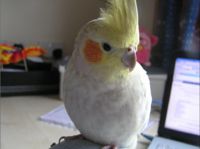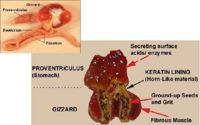Difference between revisions of "Avian Digestive Tract - Anatomy & Physiology"
(Redirected page to Category:Avian Alimentary System - Anatomy & Physiology) |
|||
| (17 intermediate revisions by 3 users not shown) | |||
| Line 1: | Line 1: | ||
| − | + | {{toplink | |
| + | |backcolour =BCED91 | ||
| + | |linkpage =Alimentary - Anatomy & Physiology | ||
| + | |linktext =Alimentary System | ||
| + | |maplink = Alimentary (Concept Map)- Anatomy & Physiology | ||
| + | |pagetype =Anatomy | ||
| + | }} | ||
| + | <br> | ||
| + | [[Image:Cockatiel.jpg|thumb|right|200px|Cockatiel - Copyright nabrown 2008]] | ||
| + | ==Introduction== | ||
| + | |||
| + | Birds are endothermic vertebrates, many with a high core temperature of 41.3°C. The rapid heart rate (93-494 bpm) and respiratory rate (12-85) explain the fast metabolic rate of the avian species. This high basic metabolic rate influences the rate of drug absorbtion, metabolism and excretion and should be taken into account when anaesthetising these animals. | ||
| + | |||
| + | Food can move retrograde from the [[The Proventriculus - Anatomy & Physiology|proventriculus]] to the [[Crop- Anatomy and Physiology|crop]]. Food can also pass from the [[The Gizzard - Anamtomy & Physiology|gizzard]] back into the [[The Proventriculus - Anatomy & Physiology|proventriculus]] depending on particle size, which is similar to that in mammals. The egestion of bones occurs once the nutritious material has been ingested. During reflux, gastric motility is inhibited and the pellet is expelled through the [[The Avian Oral Cavity - Anatomy & Physiology|oral cavity]] by oesophageal antiperistaltis. This cleans the [[Crop- Anatomy and Physiology|crop]] out and checking the pellet of captive birds should be undertaken daily to assess health. | ||
| + | |||
| + | The avian ailimentary system differs immensely from the basic mammalian design. | ||
| + | |||
| + | [[Image:Avian GIT.jpg|thumb|right|200px|Avian GIT Overview - Copyright Nottingham 2008]] | ||
| + | |||
| + | |||
| + | |||
| + | ::[[The Avian Tongue - Anatomy & Physiology|The Tongue]] | ||
| + | |||
| + | ::[[The Avian Hard Palate - Anatomy & Physiology|The Hard Palate]] | ||
| + | |||
| + | ::[[Crop- Anatomy and Physiology|The Oesophagus and Crop]] | ||
| + | |||
| + | ::[[The Avian Intestines - Anatomy & Physiology|The Intestines]] | ||
| + | |||
| + | ::[[Avian Liver - Anatomy & Physiology|The Liver]] | ||
| + | |||
| + | ::[[The Avian Vent and Cloaca - Anatomy & Physiology|The Vent and Cloaca]] | ||
Revision as of 20:00, 21 June 2010
|
|
Introduction
Birds are endothermic vertebrates, many with a high core temperature of 41.3°C. The rapid heart rate (93-494 bpm) and respiratory rate (12-85) explain the fast metabolic rate of the avian species. This high basic metabolic rate influences the rate of drug absorbtion, metabolism and excretion and should be taken into account when anaesthetising these animals.
Food can move retrograde from the proventriculus to the crop. Food can also pass from the gizzard back into the proventriculus depending on particle size, which is similar to that in mammals. The egestion of bones occurs once the nutritious material has been ingested. During reflux, gastric motility is inhibited and the pellet is expelled through the oral cavity by oesophageal antiperistaltis. This cleans the crop out and checking the pellet of captive birds should be undertaken daily to assess health.
The avian ailimentary system differs immensely from the basic mammalian design.

